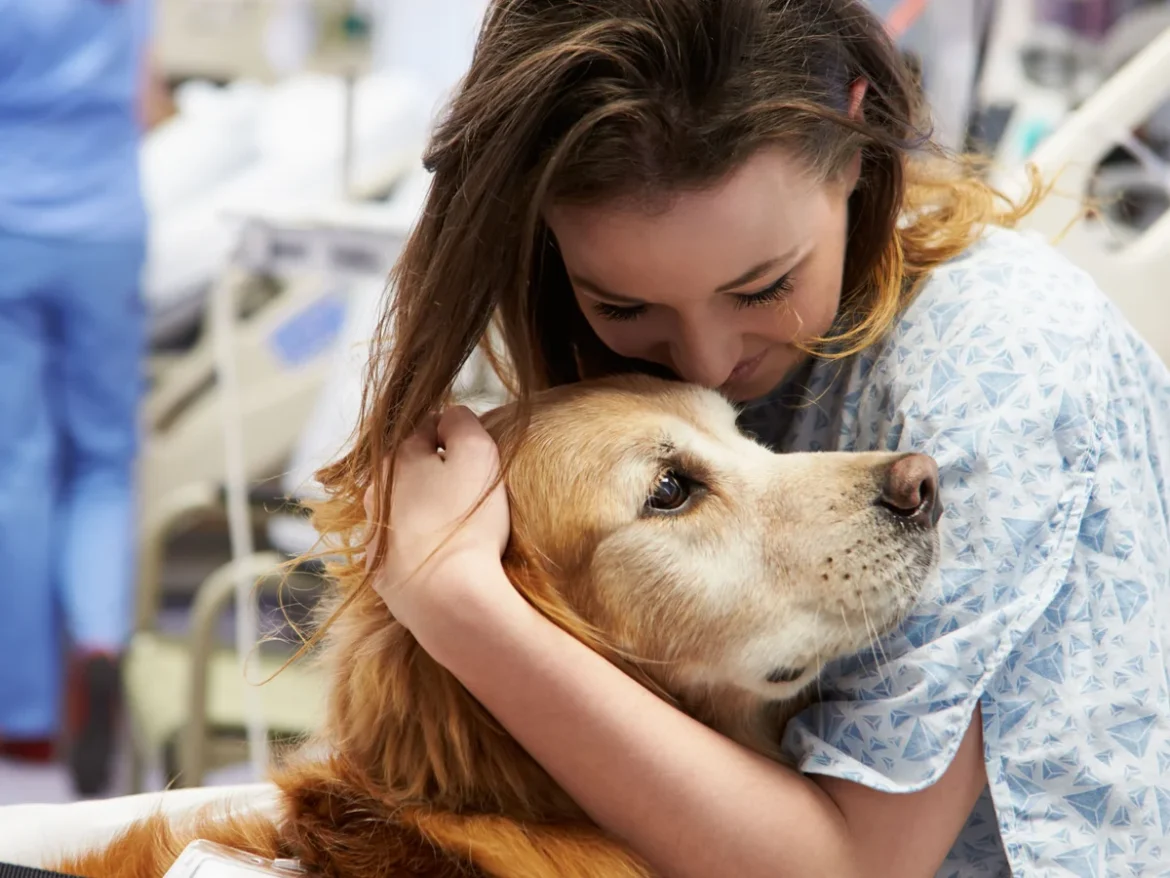Vaccinations, diet, and exercise are the first things that people think of when they think about pet health. The mental and emotional aspects of things are frequently disregarded.
Dogs and cats can suffer from stress, anxiety, and even depression, just like people do. The distinction is that they are unable to sit you down and tell you, “Hey, I’m not doing well.” Subtle changes in routine, energy, and behaviour are how they communicate.
Recognising that an animal’s emotional state is as important to their general well-being as their physical state is the first step towards understanding pet mental health, not “humanising” them needlessly.
Additionally, if stress and anxiety are not managed, they may develop into expensive medical conditions or behavioural disorders that weaken your relationship with them.
Why Mental Health in Pets Matters
Consider this: a dog that is anxious is more than just nervous. Prolonged anxiety can impair their immune system, lead to digestive issues, and result in destructive behaviours like excessive barking or chewing on furniture.
A stressed-out cat may become withdrawn, stop using the litter box, or get UTIs. To put it another way, neglecting mental health eventually manifests as behavioural problems or physical illness, which lowers their level of happiness.
Therefore, it’s crucial to learn how to spot emotional warning signs early on.
Signs of Stress in Cats and Dogs
Pets typically experience stress when their surroundings, routines, or interactions abruptly change.
The underlying patterns are surprisingly similar, although the signs vary slightly between species.
Dogs Under Stress excessive drooling or panting, even in cold weather. restlessness or pacing that doesn’t go away. excessive shedding during stressful situations, such as when visiting the veterinarian. yawning or lip-licking in non-normal situations. attempting to flee or hiding behind you.
Cats Under Stress excessive grooming that results in bald areas. hiding for extended periods of time in odd locations. When overstimulated, the pupils dilate or the tail flicks. refusal to eat when under stress or after.
Hissing or abrupt hostility in previously peaceful settings.
Read Also: Addressing Separation Anxiety in Pets: Training Tips, Products, and When to Call a Vet
Signs of Anxiety in Cats and Dogs
Anxiety differs from stress in that it’s more chronic. Stress is often situational and temporary. Anxiety lingers, showing up as constant worry or hyper-vigilance.
Anxiety in Dogs
- Separation anxiety: whining, barking, or destructive chewing when left alone.
- Compulsive behaviors: spinning, chasing their tail, or obsessive licking.
- Excessive clinginess: following you everywhere in the house.
- Refusal to eat when you’re gone.
Anxiety in Cats
- Litter box avoidance: urinating in corners or on clothes.
- Over-vocalization: meowing or yowling excessively, especially at night.
- Hyper-alertness: ears constantly twitching at every sound.
- Aggression toward other pets or people without obvious reason.
Signs of Depression in Cats and Dogs
Yes, pets can become depressed. It often happens after major changes like the loss of a companion, relocation, or neglect of social needs.
Depression in Dogs
- Loss of interest in play or walks.
- Sleeping more than usual.
- Refusing food or eating far less.
- Withdrawing from people they usually adore.
- Low energy, no tail wag, less responsiveness.
Depression in Cats
- Neglecting grooming, appearing scruffy.
- Sleeping excessively (more than their normal 15+ hours).
- Lack of interest in toys or social interaction.
- Loss of appetite or sudden weight change.
- Silent withdrawal—no longer greeting you or interacting.
What Causes Mental Health Problems in Pets?
The root of stress, anxiety, or depression in pets is usually a mix of environment, genetics, and health conditions.
- Lack of stimulation: Bored pets get restless, destructive, and sad.
- Past trauma: Rescues may carry baggage from abuse, abandonment, or neglect.
- Changes in routine: New homes, moving furniture, a new baby, or your work schedule can throw them off.
- Medical issues: Pain, thyroid problems, or neurological conditions can mimic or trigger mental health issues.
- Loss of a companion: Pets grieve too, whether it’s another pet or a beloved human.
- Owner’s emotional state: Pets are sensitive. Your stress and mood can rub off on them.
Supporting Your Pet’s Mental Health
The good news: with attention and care, many pets can bounce back from mental health struggles. It often starts with small adjustments in daily life.
1. Provide Mental and Physical Stimulation
- Dogs: Daily walks, puzzle feeders, obedience training, scent games.
- Cats: Climbing trees, window perches, interactive toys, food-dispensing puzzles.
Stimulation burns off nervous energy and keeps their brains engaged.
2. Maintain a Predictable Routine
Pets thrive on consistency. Feeding, walks, playtime, and bedtime at predictable times create stability.
3. Create Safe Spaces
- A crate for dogs (when introduced positively) gives them a den-like retreat.
- A quiet hideaway for cats—like a covered bed or a box in a low-traffic room—lets them decompress.
4. Positive Reinforcement Training
Reward calm, desired behaviors instead of punishing anxious or stressed reactions. Harsh correction only amplifies fear.
5. Social Interaction
Companionship matters. Dogs especially need social interaction with people or other dogs. For cats, controlled play sessions can be enough.
6. Environmental Enrichment
- Rotate toys weekly.
- Introduce scratching posts or chew toys.
- Use calming pheromone diffusers (like Feliway for cats or Adaptil for dogs).
7. Veterinary Help
If symptoms persist, a vet check is crucial. They may recommend:
- Medical tests to rule out underlying illness.
- Behavioral therapy referrals.
- Medication (anti-anxiety or antidepressants for pets exist).
When to Call a Vet Immediately
Don’t wait too long hoping they’ll “snap out of it.” Call a vet if:
- Appetite changes last more than 2–3 days.
- Sudden aggression appears with no trigger.
- They isolate completely or stop grooming.
- Self-harm behaviors (excessive licking, biting themselves).
- Any overlap with physical illness symptoms like vomiting or diarrhea.
How Owners Sometimes Make It Worse (Without Realizing)
It’s easy to accidentally reinforce negative behaviors. Common mistakes:
- Over-comforting anxious behavior: If you fuss over a whining dog every time you leave, you may validate the fear.
- Punishing stress signals: Yelling at a cat for hiding or a dog for barking compounds the problem.
- Inconsistent training: Sending mixed signals confuses pets and raises anxiety.
The Bigger Picture: Your Pet Mirrors Your Energy
Pets are often emotional mirrors. If you’re constantly stressed, your pet may become tense too. Caring for your mental health benefits them as much as it benefits you.
It’s worth asking yourself: Am I creating an environment that encourages calmness, or one that fuels tension?
FAQs on Pet Mental Health
- Can pets really suffer from depression like humans?
Yes, though it’s expressed differently. Pets won’t cry or verbalize sadness, but their behaviors (withdrawal, appetite loss, lethargy) can mirror human depression. - Do pets outgrow anxiety?
Not always. Some improve with training and time, but chronic anxiety often needs intervention. - Can mental health issues shorten a pet’s lifespan?
Indirectly, yes. Chronic stress weakens the immune system, leading to illness. Depression often suppresses appetite, which can cause long-term health decline. - What role does exercise play in mental health?
A huge one. Regular exercise releases endorphins, reduces stress, and prevents destructive boredom behaviors. - Are medications safe for anxious or depressed pets?
When prescribed by a vet, yes. Options like fluoxetine (Prozac) or clomipramine are commonly used in severe cases, often alongside behavior therapy. - Can cats have separation anxiety like dogs?
Yes, though it shows differently—excessive vocalization, destructive scratching, or urination outside the litter box. - How do I know if my pet needs professional help?
If changes in appetite, energy, or social behavior last longer than a week, or if their actions pose harm to themselves, your property, or others, it’s time to seek help.
Final Thoughts
Your cat or dog doesn’t just need food, water, and shelter. They need emotional stability and a sense of safety. Paying attention to their mental health is part of responsible ownership, and it strengthens the bond you share.
Stress, anxiety, and depression in pets aren’t just “quirks” to overlook—they’re signals. The earlier you notice and address them, the easier it is to turn things around.
So, the next time your dog refuses his favorite toy or your cat hides under the bed for days, pause before dismissing it. Ask yourself: What’s going on in their world that might be weighing them down?
Because when you look after their mind as much as their body, you’re not just caring for a pet—you’re honoring a companion who depends on you to help them thrive.



